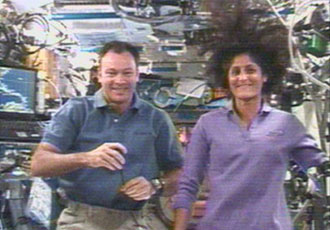ISS Crew Prepares for Record Setting Spacewalks

Astronauts aboard the International Space Station (ISS) are gearing up for a record-setting quartet of spacewalks, the first of which kicks off next week.
ISS Expedition 14 commander Michael Lopez-Alegria and flight engineer Sunita Williams are poised to make a series of extravehicular activities (EVAs) in nine days to overhaul the space station's primary cooling system and install new components to the outpost's exterior. A fourth, unrelated spacewalk -- to be performed by Lopez-Alegria and flight engineer Mikhail Tyurin -- is slated for Feb. 22.
By the end of February, both Lopez-Alegria and Williams will hold new U.S. spacewalking titles, NASA officials said.
"This will be the first time that we've executed more than a single stage EVA at a time," Glenda Laws, NASA's lead Expedittion 14 spacewalk officer, said in a mission briefing Friday. "We're going to be knocking out three, one right after another."
Lopez-Alegria and Williams will perform each of the first three spacewalks -- scheduled for Jan. 31, Feb. 4 and Feb. 8 -- in U.S. spacesuits. The fourth spacewalk, which is primarily aimed at freeing a cargo ship antenna currently jammed against an ISS handrail, will be staged in Russian Orlan spacesuits.
The primary goals of the first two spacewalks will be to switch the station's temporarily cooling lines, which transport liquid ammonia to cool ISS electronics, into a more permanent configuration and retract a pair of no longer needed radiators. Lopez-Alegria and Williams will then remove a pair of thermal blankets -- which spacewalk planners compared to ultra king-sized sheets -- from the station's portside truss segment and perform some maintenance tasks.
The Expedition 14 spacewalkers will take great care while wrangling the ammonia cooling line to avoid contamination in the event of a leak like that which occurred in 2001 as astronauts installed the U.S. Destiny laboratory during the STS-95 mission.
Breaking space news, the latest updates on rocket launches, skywatching events and more!
"We've been training together with this crew for almost two years," Laws said, adding that both the Expedition 14 crew and flight controllers are ready to handle an ammonia leak among other contingencies. "We kind of are even treating that almost as a nominal activity because it's become such second nature to us to follow up on those kinds of contingencies."
Spacewalk records await
It's not uncommon for astronauts to perform several spacewalks within the same week at the ISS during a shuttle mission, though those EVAs are typically performed by the visiting shuttle crew and not the station spaceflyers. For example, during NASA's STS-116 mission in December, for example, staged four EVAs last month to rewire the ISS and activate its primary cooling system, for example.
But ISS crews have typically taken their spacewalking tasks a bit slower due to the daily strain of their long-duration spaceflights.
By the end of February, Williams will have racked up the most spacewalks ever performed by a female astronaut (four) while Lopez-Alegria will complete his 10th EVA and set a new U.S. record, NASA officials said.
Derek Hassman, NASA's lead flight director for the Expedition 14 spacewalks said the astronauts will have relatively light days between their planned spacewalks, with their schedules packed with only half the chores typical of an average station day. Flight controllers will also work closely with the astronauts to ensure they are well rested and, if needed, the spacewalk schedule can be adjusted to allow more rest time, Hassman added.
"Our goal is to finish these three spacewalks prior to the Russian EVA," Hassman said. "We have really as much flexibility as we need to take...we're going to take the time we need to make sure the crew is recovered from the first [spacewalk] before we go to the second."
The first of the upcoming four Expedition 14 spacewalks is scheduled begin at 10:00 am. EST (1500 GMT) on Wednesday, Jan. 31 and will be broadcast live on NASA TV.
- Martha Stewart Makes Orbital Call to ISS Crew
- VIDEO: NASA Astronaut Jeff Williams' ISS Music Video
- Complete Coverage: ISS Expedition 14
- All About the International Space Station

Tariq is the award-winning Editor-in-Chief of Space.com and joined the team in 2001. He covers human spaceflight, as well as skywatching and entertainment. He became Space.com's Editor-in-Chief in 2019. Before joining Space.com, Tariq was a staff reporter for The Los Angeles Times covering education and city beats in La Habra, Fullerton and Huntington Beach. He's a recipient of the 2022 Harry Kolcum Award for excellence in space reporting and the 2025 Space Pioneer Award from the National Space Society. He is an Eagle Scout and Space Camp alum with journalism degrees from the USC and NYU. You can find Tariq at Space.com and as the co-host to the This Week In Space podcast on the TWiT network. To see his latest project, you can follow Tariq on Twitter @tariqjmalik.
